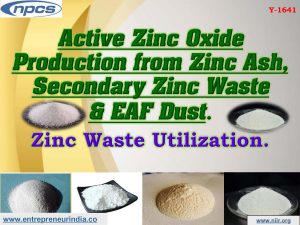Active Zinc Oxide from Zinc Ash

Active Zinc Oxide Production from Zinc Ash, Secondary Zinc Waste & EAF Dust. Zinc Waste Utilization.
Active zinc oxide, with its unique physical and chemical properties, like high chemical stability, high electrochemical coupling coefficient, broad range of radiation absorption and high photo stability, may be a multifunctional material. With the wonderful properties, Active zinc oxide plays a very important role during a very wide range of applications varying from tires to ceramics, from pharmaceuticals to agriculture, and from paints to chemicals. Active zinc oxide are often classified into three types consistent with the production technique: indirect process, direct process and wet chemical change.
Related Project:- Active Zinc Oxide From Zinc Ash, Secondary Zinc Waste & Eaf Dust
Active ZnO Applications:
In many applications, grades with high specific surface area allow more than remarkable savings because of their high reactivity and their excellent dispersion and fluidity properties.
The principal advantages of active zinc oxides are listed below:
Reduced ZnO usage in rubber applications with equal performance
Very high level of activity, even in very low concentrations
High level of purity: very low heavy metal content
Increased production capacity
Improved physical properties
Better resistance to compression set
Better aging resistance
Rubber
Coating
Ceramics
Pharmaceutical
Fertilizer
Electronics
Related Project: – Chemicals (Organic, Inorganic, Industrial) Projects
Manufacturing Process:
For industrial use, ZnO is produced at levels of 105 tons per year by three main processes:
Indirect process: In the indirect or French process, metallic zinc is melted in a graphite crucible and vaporized at temperatures above 907 °C (typically around 1000 °C). Zinc vapor reacts with the oxygen in the air to give ZnO, accompanied by a drop in its temperature and bright luminescence. Zinc-Oxide particles are transported into a cooling duct and collected in a bag house. This indirect method was popularized by Le Claire (France) in 1844 and therefore is commonly known as the French process. Its product normally consists of agglomerated zinc oxide particles with an average size of 0.1 to a few micrometers. By weight, most of the world’s zinc oxide is manufactured via French process.
Direct process: The direct or American process starts with diverse contaminated zinc composites, such as zinc ores or smelter by-products. The zinc precursors are reduced (carbothermal reduction) by heating with a source of carbon such as anthracite to produce zinc vapor, which is then oxidized as in the indirect process. Because of the lower purity of the source material, the final product is also of lower quality in the direct process as compared to the indirect one.
Wet chemical process: A small amount of industrial production involves wet chemical processes, which start with aqueous solutions of zinc salts, from which zinc carbonate or zinc hydroxide is precipitated. The solid precipitate is then calcined at temperatures around 800 °C.
Related Books: – Chemical Technology (Organic, Inorganic, Industrial), Fine Chemicals
Market Outlook
The global Active zinc oxide (ZnO) market size is projected to grow from USD 4.4 billion in 2019 to USD 5.7 billion by 2024, at a compound annual growth rate (CAGR) of 5.4%, during the forecast period. ZnO is a white inorganic compound that is used widely in pharmaceuticals, rubber, ceramics cosmetics, chemicals, and glass industries. The growth of these end-use industries is expected to fuel the global Active zinc oxide market demand over the forecast period.
Increasing demand of Active Zinc oxide in chemical and manufacturing industry will further boost the market size. Industrial application of the product majorly vulcanization of rubber will surge significantly in forecast period. Tire industry is also one the major consumer of the product. Other major application including manufacturing of concrete, photovoltaic, electronic, optoelectronic devices and glass cutting.
The demand for zinc oxide is growing due to its increasing application in electronics and semiconductors. High production of smart devices has positively influenced the electronics industry. Further, the growing utilization of zinc oxide in cosmetic products is the key driving factor for the market. Furthermore, the inclination toward multipurpose products among the working population has triggered the growth in the adoption of skincare ingredients. There is also a high demand for skin lightening products in Asian and Middle Eastern population. Moreover, the sales of simple daily beauty use beauty products with the benefits of anti-aging, moisturizing, cleansing, UV protection, and antioxidant are high. Such trends are leading to the increasing use of zinc oxide in cosmetic products.
Market Research: – Market Research Report
Key Players:-
Chemspec Chemicals Pvt. Ltd.
Nav Bharat Metalic Oxide Inds. Pvt. Ltd.
Rubamin Pvt. Ltd.
Transpek-Silox Industry Pvt. Ltd.
The major players in the market include US Zinc, Zochem, Umicore, Chemet, Zinc Nacional, Zinc Oxide LLC, Silox, GH Chemicals, Rubamin, Grillo, Pan-Continental Chemical, Mario Pilato, Brueggemann, A-Esse, Hakusui, Seyang, Yongchang, Longli, Zhongse, etc.